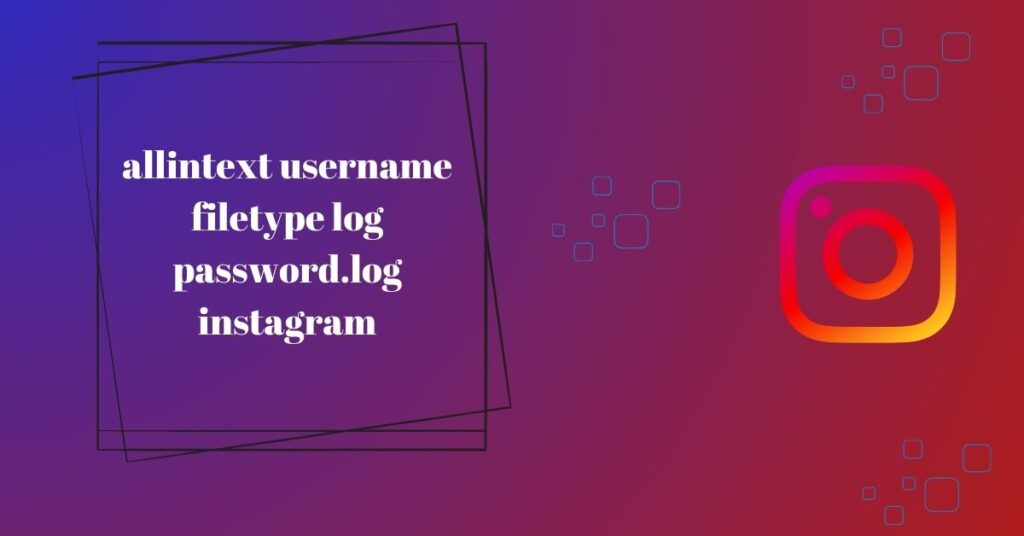
Contents
- 1 Introduction to Instagram and Its Security Measures
- 2 The Risks and Vulnerabilities of allintext username filetype log password.log instagram Users
- 3 How Hackers Exploit These Vulnerabilities
- 4 Preventive Measures to Protect Your Instagram Account
- 5 What to Do if Your Instagram Account Has Been Hacked
- 6 Conclusion:
- 7 FAQs
- 7.1 1. Can hackers access my Instagram account using the allintext username filetype log password.log instagram search query?
- 7.2 2. How do hackers exploit vulnerabilities in Instagram?
- 7.3 3. What preventive measures should I take to protect my Instagram account?
- 7.4 4. What should I do if my Instagram account has been hacked?
- 7.5 5: Why is staying vigilant important in the digital age?
- 7.6 Latest Post!
Introduction to Instagram and Its Security Measures
Greetings from Instagram, a place where original ideas and eye-catching images rule! This social networking platform has over a billion active members globally and has become essential to our digital lives. Instagram provides countless opportunities for self-expression, from connecting with friends and influencers to sharing beautiful moments.
But beneath the glamour and energy of this thriving virtual community, there’s a dark side that needs our attention: the dangers and weaknesses that could jeopardize the security of your Instagram account. In this blog post, we will examine the possible risks associated with allintext username filetype log password.log searches on Instagram and explain how hackers exploit these weaknesses to further their harmful goals.
So buckle up because we’re about to peek inside Instagram’s security protocols. Learn how to protect yourself from online risks while taking advantage of all that this eye-catching platform has to offer. Now, let’s get started!
The Risks and Vulnerabilities of allintext username filetype log password.log instagram Users
With millions of users sharing their images and experiences daily, Instagram is one of the world’s most widely used social networking sites. Instagram users need to be aware of the hazards and vulnerabilities that come along with the platform’s enormous popularity. The plaintext username filetype log password.log technique is a vulnerability that hackers use to access user accounts without authorization.
Using this strategy, you search the internet for files with necessary login credentials, like passwords and usernames. Hackers can limit the files in their search results by utilizing sophisticated search operators like “allintext.” In this instance, they are searching for files in the log file type containing usernames and passwords.
Hackers can obtain unauthorized access to user accounts by using the log files that include Instagram user credentials once they discover them. They might try various strategies, like phishing or brute force assaults, to break passwords or fool users into disclosing private information.
A hacked Instagram account might have serious repercussions. Hackers can take control of your account until you pay a ransom, steal personal information, and post malicious stuff on your behalf. Furthermore, they might propagate spam or carry out other fraudulent actions by taking advantage of the legitimacy and reach of your account.
It would help if you took preventive action to shield yourself from these hazards and weaknesses. For your Instagram account, start with secure and original passwords; avoid utilizing well-known phrases or quickly guessed string combinations of letters and digits. For extra protection, turn on two-factor authentication (2FA), which requires you to provide a verification code you receive by email or SMS each time you attempt to log in from a different device.
Additionally, use caution when opening unexpected attachments or clicking on dubious links that appear to be from Instagram. These could be phishing attempts meant to obtain your login information. Update your operating system and apps regularly since software updates frequently come with security patches that fix known vulnerabilities. Act immediately if your Instagram account has been hacked despite your best attempts.
How Hackers Exploit These Vulnerabilities
Hackers are always searching for weak points in systems, and Instagram is no different. Instagram users have devised several strategies to capitalize on the dangers and weaknesses present in plaintext username filetype log password.log. You can better secure your account with a better awareness of how hackers exploit these weaknesses.
Phishing attacks are one method by which cybercriminals take advantage of these weaknesses. They can ask for your login information via an ostensibly authentic email or message purporting to be from Instagram. They can access your account without authorization once you provide this information.
Hackers also employ brute force attacks as a method. They use automated systems that repeatedly attempt various username and password combinations until they identify the right ones. This emphasizes the importance of solid and one-of-a-kind passwords for your Instagram account.
Additionally, third-party websites or apps that use Instagram’s API (Application Programming Interface) could be the target of hackers. Weak security measures make it easier for hackers to obtain user data and compromise users’ accounts on these apps or websites.
Hackers may also take advantage of software flaws in the Instagram platform itself. Thanks to these vulnerabilities, they can get around security measures or access user accounts without authorization,
Maintain alertness and take precautions against these exploits, like turning on two-factor authentication, changing your password regularly, being wary of dubious emails or messages requesting personal information, and only accessing your account from secure networks and devices.
Remember that you could still become the target of a hacking effort even if you have taken precautions. Suppose your Instagram account has been hacked despite your security measures. In that case, you must restore control and assess any potential harm the hacker may have caused, such as unauthorized changes or the exposure of personal information.
Preventive Measures to Protect Your Instagram Account
Ensuring your online accounts are secure is more crucial than ever in this digital age. Instagram has a vast user base and is very popular, which makes it a target for hackers and other online criminals. It’s critical to take precautions to protect your account and personal information.
Make a strong password out of alphanumeric characters, capital letters, and special characters. Steer clear of commonly used terms or birthdays as easily guessed passwords. To guarantee optimal security, change your password regularly.
Activate 2FA (two-factor authentication) on your Instagram profile. RequiringRequesting a password and verification number to be delivered to your mobile device before allowing access increases security even further. Even if someone manages to get their hands on your login information, it dramatically lessens the likelihood of unwanted access.
Use caution while opening attachments or accessing links from unidentified sources. Phishing scams are commonplace online, where hackers attempt to fool you into divulging private information using phony emails or texts.
Check your Instagram account’s privacy settings frequently. By changing these settings, you may manage who can send direct messages, comment on your posts, and view them. Restricting access to trusted followers merely reduces vulnerability to possible dangers.
Watch out for dubious third-party apps that say they can improve your Instagram account’s features or aesthetics. These apps could jeopa and resize Your Instagram account and the security of other connected social networking sites.
Keep yourself informed about the most recent developments in hacking techniques and cybersecurity dangers that affect social media accounts such as Instagram. Knowing the possible dangers helps you react quickly and take the required safety measures before being attacked.
What to Do if Your Instagram Account Has Been Hacked
It can be unpleasant to learn that your Instagram account has been compromised. However, you must remain composed and act immediately to recover control of your account. In the unfortunate event that you find yourself in this circumstance, you should take the following actions.
1. Change Your Password:
Resetting your password should be your first step. Select a robust, unique password that combines letters, numbers, and symbols. This will contribute to maintaining the security of your account in the future.
2. Enable Two-Factor Authentication:
Set up two-factor authentication to provide another degree of protection. When using this function to access your account from an unidentified device or location, you must provide a verification number and password.
3. Check for Suspicious Activity:
Examine your account’s recent posts, messages, and modifications without authorization or knowledge. Pay close attention to the activity on your account. Any unlawful action should be reported right once.
4. Contact Instagram Support:
Contact the Instagram support team via social media or their Help Center to report the hacking occurrence and request help getting your account back.
5. Update Security Settings:
Check and update all security settings, including connected email addresses and account phone numbers, as soon as you can reaccess your account.
Recall that when it comes to internet security, prevention is critical. Hackers can be avoided by changing passwords regularly, exercising caution when clicking on dubious websites or emails, and keeping up with emerging dangers.
Conclusion:
In summarizing this blog article, we must stress how critical it is to maintain awareness in the digital age. People rely increasingly on social networking sites like Instagram, so they must understand the dangers and weaknesses that could jeopardize their accounts.
In today’s linked world, cybercriminals constantly develop new techniques to exploit holes in online security measures. One example of how easily personal information might end up in the wrong hands is the risks Instagram users face when using the plaintext username filetype log password.log.
By being aware of the potential exploits for these vulnerabilities, we can better equip ourselves to take preventative action and safeguard our Instagram accounts. This entails setting up two-factor authentication, creating strong passwords, updating privacy settings frequently, and exercising caution when disclosing sensitive information online.
But even with safeguards in place, there’s still a chance that your Instagram account might be compromised. It’s crucial in these situations to act quickly by resetting your password and reporting the occurrence to Instagram help rather than freaking out.
FAQs
1. Can hackers access my Instagram account using the allintext username filetype log password.log instagram search query?
Although this search term might theoretically allow hackers to access Instagram accounts without authorization, it’s important to remember that Instagram has implemented several security safeguards to safeguard user accounts. Users must still exercise caution and take preventative action to secure their accounts.
2. How do hackers exploit vulnerabilities in Instagram?
Hackers can take advantage of Instagram vulnerabilities using various strategies, such as social engineering, brute force assaults, and phishing scams. By employing these strategies, they can fool people into disclosing their login information or allow them to access their accounts without authorization.
3. What preventive measures should I take to protect my Instagram account?
To make your Instagram account more secure:
Make sure your password is strong and distinct. Turn on two-factor authentication. Update the operating system and programs on your smartphone regularly. Exercise caution when responding to shady emails or messages requesting login credentials. Steer clear of downloading unfamiliar files or clicking on dubious links.
4. What should I do if my Instagram account has been hacked?
Should you think that someone has gained access to your Instagram account:
1. Modify your password right away.
2. Examine your account for any instances of unauthorized activity.
3. Use Instagram’s support channels to report the event.
4. Let your followers know about the hack to prevent them from becoming victims.
5. Check any connected accounts (like email) for indications of compromised security.
5: Why is staying vigilant important in the digital age?
Being alert is essential in the modern digital age because cybercriminals are constantly improving their methods and looking for new ways to take advantage of weaknesses in the internet. We can reduce the likelihood of becoming victims of cyberattacks by being vigilant and taking proactive steps to secure our personal information online.
Recall that protecting our online reputation involves ongoing attention to detail and proactive involvement in preserving the security of our accounts and private data.






